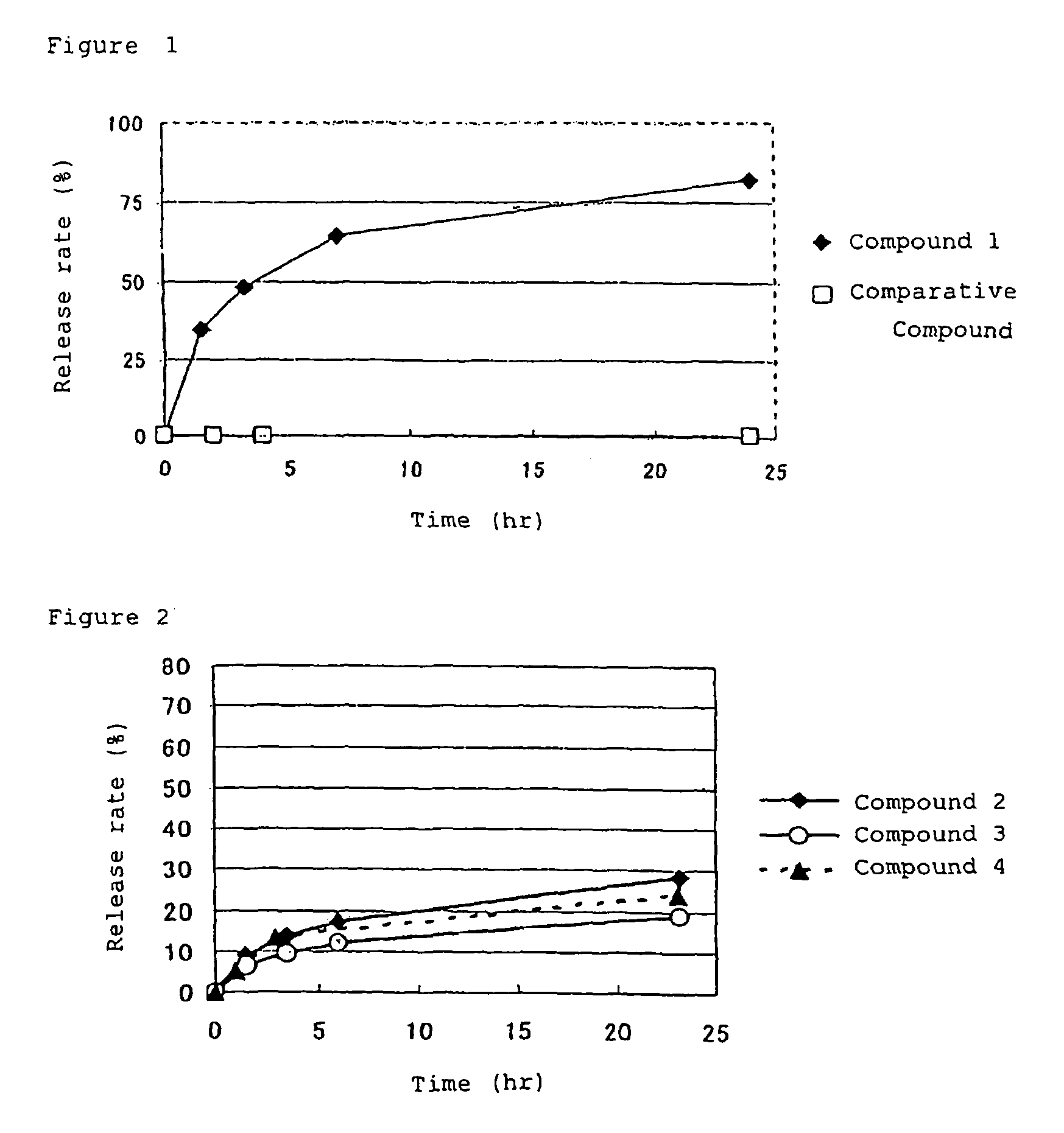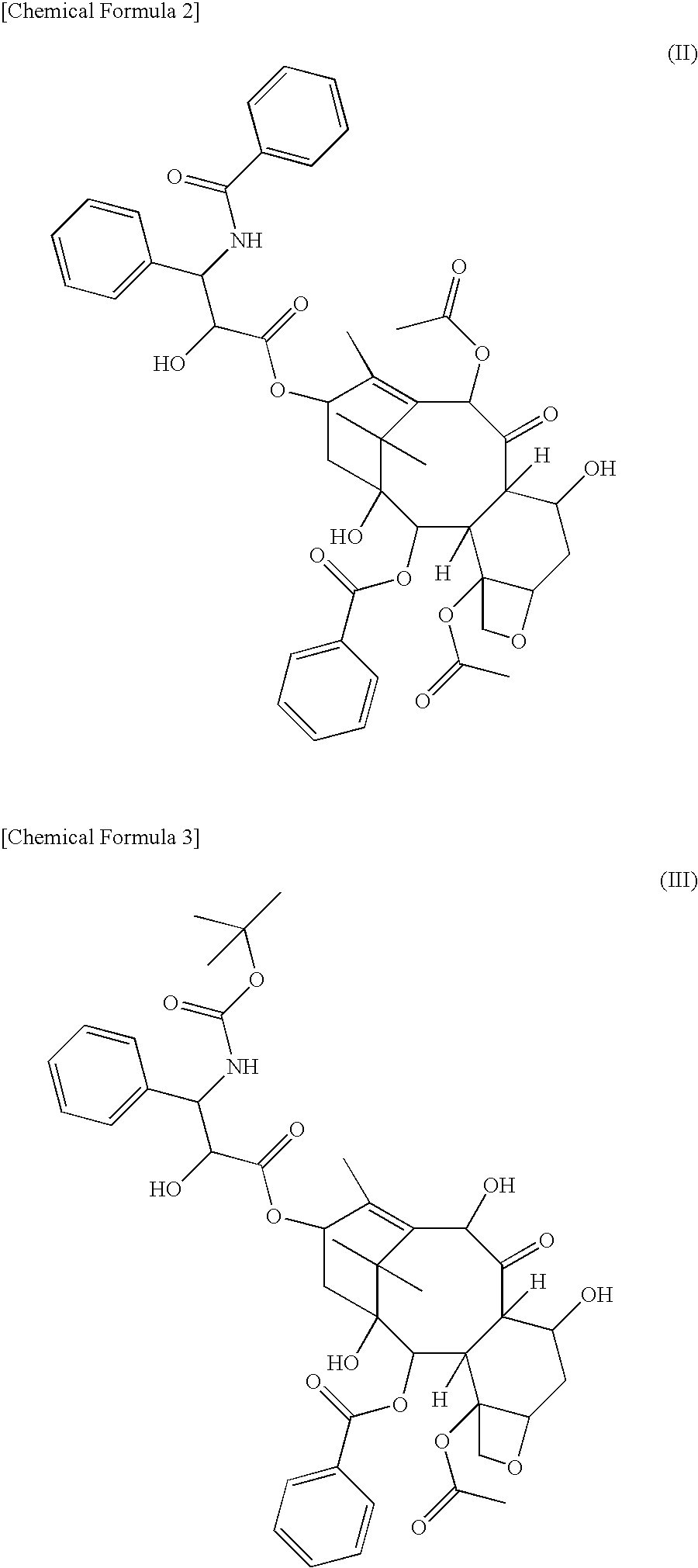Polymer conjugate of taxane
a technology of polymer conjugate and taxane, which is applied in the direction of synthetic polymer active ingredients, organic active ingredients, drug compositions, etc., can solve the problem of large amount of polymer required for the effective amount of drug administration, and achieve the effect of effective therapeutic effects
- Summary
- Abstract
- Description
- Claims
- Application Information
AI Technical Summary
Benefits of technology
Problems solved by technology
Method used
Image
Examples
example 1
[0066]Synthesis of compound 1 (conjugate of paclitaxel and a block copolymer comprising a methoxypolyethylene glycol moiety having a molecular weight of 12,000 and a polyaspartic acid moiety having a polymerization number of 35: general formula (I) in which R1=Me (methyl group), R2=trimethylene group, R3=Ac (acetyl group), R4=paclitaxel residue, R5=isopropylaminocarbonylisopropylamino group, d+e+f+g+h+i+j=35, t=273)
[0067]A methoxypolyethylene glycol-polyaspartic acid block copolymer (polymerization number of aspartic acid: 35, 15.4 mg) prepared according to the method described in Patent Document 4 and commercially available paclitaxel (10 mg) were dissolved in DMF (1 ml), and DMAP (0.8 mg) and DIPC (0.01 ml) were added thereto. The mixture was stirred for 20 hours at 25° C. Ethanol (3 ml) and diisopropyl ether (12 ml) were added to the reaction liquid, and the mixture was stirred for 30 minutes at room temperature. Subsequently, the precipitate was collected by filtration, and wash...
example 2
[0070]Synthesis of compound 2 (conjugate of docetaxel and a block copolymer comprising a methoxypolyethylene glycol moiety having a molecular weight of 12,000 and a polyaspartic acid moiety having a polymerization number of 33: general formula (I) in which R1=Me (methyl group), R2=trimethylene group, R3=Ac (acetyl group), R4=docetaxel residue, R5=isopropylaminocarbonylisopropylamino group, d+e+f+g+h+i+j=33, t=273)
[0071]A methoxypolyethylene glycol-polyaspartic acid block copolymer (polymerization number of aspartic acid: 33, 665.4 mg) prepared according to the method described in Patent Document 4 and commercially available docetaxel (300 mg) were dissolved in DMF (10 ml), and DMAP (18.5 mg) and DIPC (0.47 ml) were added thereto. The mixture was stirred for 20 hours at 15° C., and then further stirred for 4 hours at 25° C. Ethyl acetate (15 ml), ethanol (15 ml) and diisopropyl ether (120 ml) were added to the reaction liquid, and the mixture was stirred for 30 minutes at room temper...
example 3
[0074]Synthesis of compound 3 (conjugate of docetaxel and a block copolymer comprising a methoxypolyethylene glycol moiety having a molecular weight of 12,000 and a polyaspartic acid moiety having a polymerization number of 21 and a binding mode of α-binding type: general formula (I) in which R1=Me (methyl group), R2=trimethylene group, R3=Ac (acetyl group), R4=docetaxel residue, R5=isopropylaminocarbonylisopropylamino group, d+f+h+j=21, e=0, g=0, i=0, t=273)
[0075]A methoxypolyethylene glycol-polyaspartic acid block copolymer (polymerization number of aspartic acid: 21, binding mode of aspartic acid is α-binding, 259.7 mg) prepared according to Reference Example 1 describedbelow and commercially available docetaxel (100 mg) were dissolved in DMF (3 ml), and DMAP (5.1 mg) and DIPC (0.13 ml) were added thereto. The mixture was stirred for 44 hours at 15° C., and then further stirred for 5 hours at 25° C. Ethyl acetate (4 ml), ethanol (4 ml) and diisopropyl ether (40 ml) were added to ...
PUM
| Property | Measurement | Unit |
|---|---|---|
| temperature | aaaaa | aaaaa |
| concentration | aaaaa | aaaaa |
| temperature | aaaaa | aaaaa |
Abstract
Description
Claims
Application Information
 Login to View More
Login to View More - R&D
- Intellectual Property
- Life Sciences
- Materials
- Tech Scout
- Unparalleled Data Quality
- Higher Quality Content
- 60% Fewer Hallucinations
Browse by: Latest US Patents, China's latest patents, Technical Efficacy Thesaurus, Application Domain, Technology Topic, Popular Technical Reports.
© 2025 PatSnap. All rights reserved.Legal|Privacy policy|Modern Slavery Act Transparency Statement|Sitemap|About US| Contact US: help@patsnap.com



